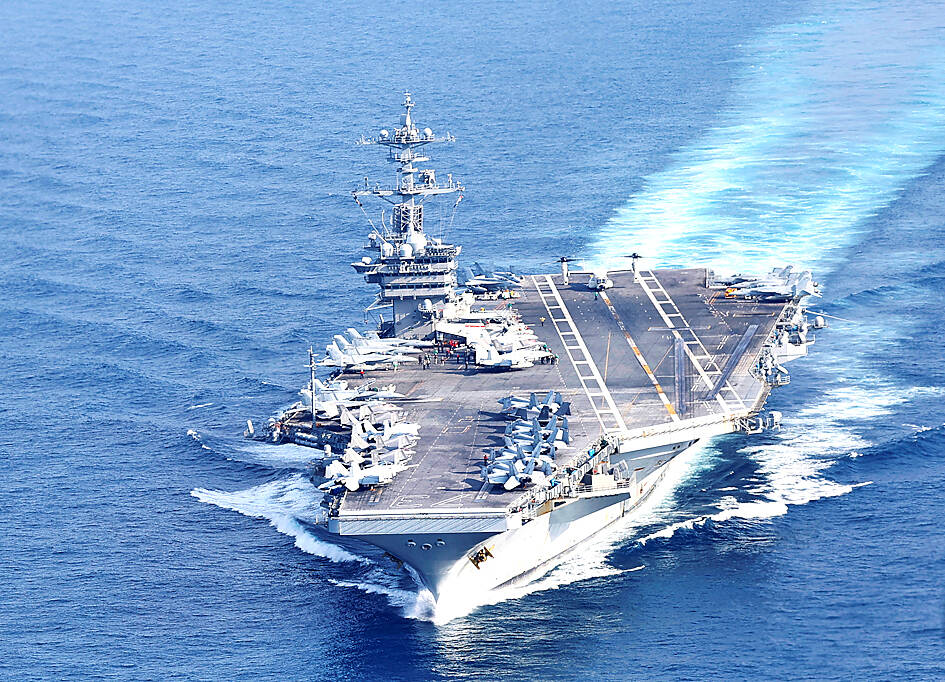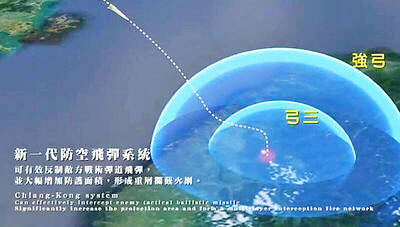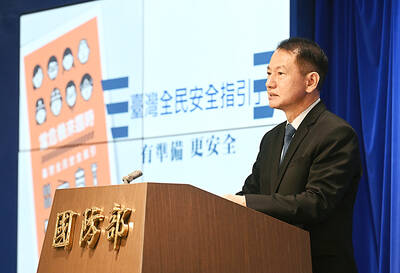The US Navy’s “mission of deterrence” in the Indo-Pacific theater applies to Taiwan, Pacific Fleet Commander Admiral Stephen Koehler told the South China Sea Conference on Tuesday.
The conference, organized by the Center for Strategic and International Studies (CSIS), is an international platform for senior officials and experts from countries with security interests in the region.
“The Pacific Fleet’s mission is to deter aggression across the Western Pacific, together with our allies and partners, and to prevail in combat if necessary, Koehler said in the event’s keynote speech.

Photo: Reuters
“That mission of deterrence applies regionwide — including the South China Sea and Taiwan,” he added.
China’s unlawful claims in the South China Sea are symptomatic of its broader ambition to establish hegemony over the region, Koehler said.
The Chinese People’s Liberation Army (PLA) has ramped up deployments and aggressive behavior in the South China Sea, while also conducting exercises simulating an invasion and blockade of Taiwan along the first island chain, he said.
Beijing’s designs extend to Southeast Asian states beyond the first island chain, using increasingly aggressive tactics to “coerce and harass them in their own waters,” he added.
The PLA and the China Coast Guard have employed water cannons, ship-to-ship collisions and lasers, even attacking the crew of a Philippine Navy supply ship with knives and axes last year, Koehler said.
The US Navy and the US Department of Defense regard the Indo-Pacific as “the priority theater,” a stance reflected in the Pacific Fleet’s strength, numbering 200 ships and submarines, 1,300 aircraft, and one-third of its forces deployed at any given time, he said.
Two aircraft carrier strike groups are active in the region: one centered on the USS Nimitz, operating in and around the South China Sea over the past months, and another centered on the USS George Washington, patrolling the western Pacific, the admiral said.
Also speaking at the conference, Japan Institute of International Affairs senior fellow Tetsuo Kotani said Tokyo is developing the “Japan Single Operational Area” strategic concept to strengthen regional defense coordination.
The concept envisions the East China Sea, South China Sea, Korean Peninsula and surrounding waters as a unified theater of military operations in which Japan and its allies act jointly, Kotani said.
However, Indo-Pacific nations would face significant challenges in maintaining peace and stability within this framework if Taiwan remains excluded from regional security arrangements, he said.
The various governments’ continued adherence to Beijing’s “one China” principle makes including Taiwan a difficult proposition, he said.
However, Taiwan should still be allowed to participate as an observer in joint military exercises such as the US-Philippine Exercise Balikatan, Rim of the Pacific (RIMPAC) and other multilateral drills, he added.

LIMITS: While China increases military pressure on Taiwan and expands its use of cognitive warfare, it is unwilling to target tech supply chains, the report said US and Taiwan military officials have warned that the Chinese People’s Liberation Army (PLA) could implement a blockade within “a matter of hours” and need only “minimal conversion time” prior to an attack on Taiwan, a report released on Tuesday by the US Senate’s China Economic and Security Review Commission said. “While there is no indication that China is planning an imminent attack, the United States and its allies and partners can no longer assume that a Taiwan contingency is a distant possibility for which they would have ample time to prepare,” it said. The commission made the comments in its annual

DETERMINATION: Beijing’s actions toward Tokyo have drawn international attention, but would likely bolster regional coordination and defense networks, the report said Japanese Prime Minister Sanae Takaichi’s administration is likely to prioritize security reforms and deterrence in the face of recent “hybrid” threats from China, the National Security Bureau (NSB) said. The bureau made the assessment in a written report to the Legislative Yuan ahead of an oral report and questions-and-answers session at the legislature’s Foreign Affairs and National Defense Committee tomorrow. The key points of Japan’s security reforms would be to reinforce security cooperation with the US, including enhancing defense deployment in the first island chain, pushing forward the integrated command and operations of the Japan Self-Defense Forces and US Forces Japan, as

INTERCEPTION: The 30km test ceiling shows that the CSIST is capable of producing missiles that could stop inbound missiles as they re-enter the atmosphere Recent missile tests by the Chungshan Institute of Science and Technology (CSIST) show that Taiwan’s missiles are capable of intercepting ballistic missiles as they re-enter the atmosphere and pose a significant deterrent to Chinese missile threats, former Hsiung Feng III missile development project chief engineer Chang Cheng (張誠) said yesterday. The military-affiliated institute has been conducting missile tests, believed to be related to Project Chiang Kung (強弓) at Pingtung County’s Jiupeng Military Base, with many tests deviating from past practices of setting restriction zones at “unlimited” and instead clearly stating a 30.48km range, Chang said. “Unlimited” restrictions zones for missile tests is

PUBLIC SAFETY: The nationwide distribution campaign aims to enhance society’s overall understanding of threats and bolster defense awareness, an official said The latest edition of the National Public Safety Guide is being mailed to all citizens starting today to foster public awareness of self-defense in the event of war or natural disasters, the Ministry of National Defense said yesterday. “The guides will be disseminated to the public to enhance society’s overall understanding of threats and bolster defense awareness, demonstrating the government’s emphasis on people’s safety and its determination to pursue self-defense,” All-out Defense Mobilization Agency Director Shen Wei-chih (沈威志) said at the ministry’s news conference. The nationwide distribution campaign was planned according to President Lai William’s (賴清德) Sept. 20 directive, he said, adding